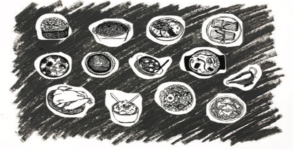It’s happening again. The invitations to walk arbitrary distances, the candlelight vigils, the fairs and information sessions, the obnoxious t-shirts, the trademarked shade of pink being dropped everywhere.
October is Breast Cancer Awareness Month. While I respectfully acknowledge the importance of the cause and the seriousness of the disease, I still have some issues with the majority of the awareness campaigning.
I’ve always felt like breast cancer was the “popular cancer” or the most popular “women’s disease.” It’s like, if you don’t get really gung-ho about breast cancer awareness, it means you hate women or something. Like breast cancer is the most serious thing that could happen to a woman.
Then there’s the “pinkwashing” of products, the obnoxious “save the titties” T-shirts, the “I love Boobies” bracelets for children… It’s questionable whether most of it (or any of it) actually benefits breast cancer awareness. You can’t go into a convenience store without seeing something with a pink ribbon on it — pink t-shirts, pink bracelets, pink energy bars, pink shampoo, pink gum, the list goes on and on. Before we know it, maybe Charmin will introduce pink toilet paper for awareness or Huggies will produce pink diapers so that your baby can join the campaigning fun, too.
It’s questionable whether most of it (or any of it) actually benefits breast cancer awareness.
As a general rule, unless a product has the Susan G. Komen logo on it, the company selling it is probably using the cause of women’s health to turn a fast profit while projecting an air of conscientiousness. You see so many products claiming to spread awareness or, by extension, to show concern for women’s health, but what are they really doing for research? What does a t-shirt proclaiming your love of mammary glands accomplish for the broader health of millions of women suffering from cancers that affect parts of the body that only they have?
So many products claim to spread awareness or show concern for women’s health, but what are they really doing for research? What does a T-shirt proclaiming love of mammary glands accomplish for the broader health of millions of women suffering from cancers which affect other parts of their bodies?
Maybe my discomfort is because cervical cancer runs in my family. My maternal grandmother died of cervical cancer in 1982 (coincidentally, the year the Susan G. Komen foundation — the most widely known, largest and best-funded breast cancer organization in the US — was established). Her mother, my great-grandmother, died of cervical cancer as did several generations of mothers and grandmothers before her. My mother is a cervical cancer survivor, and when she was diagnosed, she was told that she might not be able to have children. Despite this, I was born not too long after.
Breast cancer is easy to publicize today because the founder of the Susan G. Komen Foundation did so well publicizing it — she pioneered “cause marketing:” marketing based around a charitable cause rather than a physical product or service.
Yes, it’s important, and yes, the statistics show how incredibly widespread it is. But breast cancer is also much more physically visible: It’s easier to tell if you have a single or double mastectomy than if you have your cervix, vagina, uterus, ovaries, vulva or fallopian tubes removed for cancer treatment. Breast cancer makes it difficult to nurse one’s children, but removal of all or part of one’s female organs makes it difficult to have children at all.
In my whole life, I’ve seen only one ad for ovarian cancer awareness: a single flyer with teal and white designs that read “Ovarian cancer: the Silent Killer.” It was pinned to edge of the whiteboard of my 10th grade history class, and to my knowledge, no one (including myself) made any real comment. Anecdotal as this may be, I tend to see all gynecologic cancers as significantly more silent and less visible than the more popularly accepted breast cancer. gynecologic cancer is a cause that affects only women, yet it seems to be low priority in the hierarchy of women’s causes.
What’s important today isn’t so much that few people know about breast cancer, but that few people know just how many other types of equally important and just as easily preventable cancers there are (the short version is that there seems to be a cancer for every part of the body, including the skin, bones and blood).
Yes, breast cancer is considered a women’s disease, but men can have it, too. A man can carry HPV (it is a virus and it is considered an STD) or even the predisposition to gynecologic cancers, but he can’t manifest it. Is this not a women’s issue?
Maybe it’s just that you have no choice but to notice breasts, but people would rather not think about female reproductive organs.
But for all Mills does with the Vagina Monologues in February, I’ve never seen anything happen for Cervical Health Awareness Month (January), Ovarian Cancer Awareness Month (September) or Gynecologic Cancer Awareness Month (September).
While many out there are wearing stylish pink ribbons or “Fight like a girl” T-shirts, I’ll once again be quietly in my corner (with maybe a small display of teal and white, which seem to be the official colors of all gynecologic cancers collecively).


